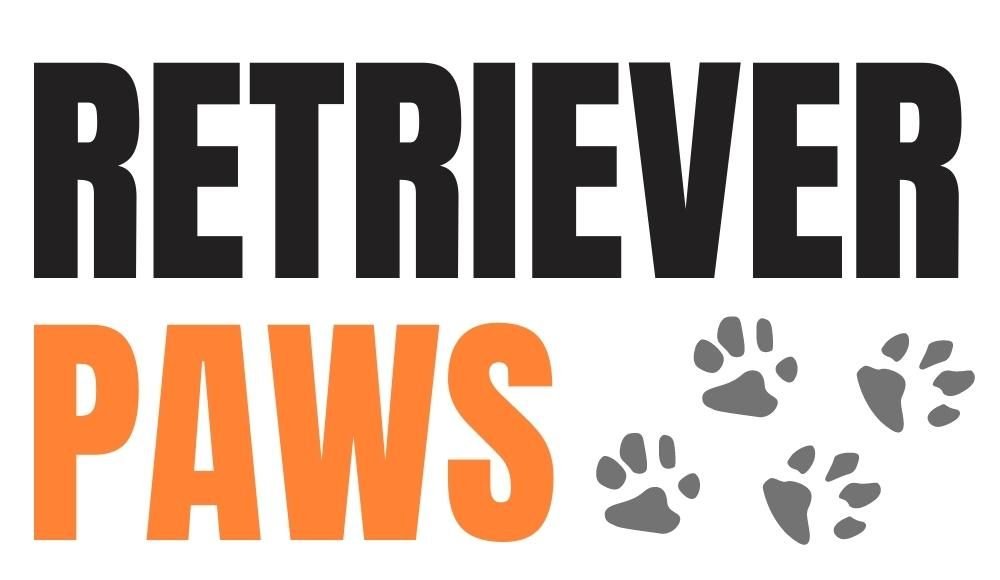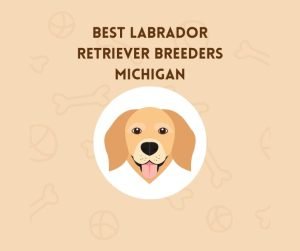Retrievers are known for their fun-loving and energetic personalities. This post contains everything you need to know about different types of retriever dogs.

If you are a dog lover, you must have heard of Labrador and Golden Retriever. But, do you know these aren’t the only retriever breeds?
There are a total of six retriever dog breeds. So, what are the six types of retrievers?
- Labrador Retriever,
- Golden Retriever,
- Chesapeake Bay Retriever,
- Curly-Coated Retriever,
- Flat-Coated Retriever, &
- Nova Scotia Duck Tolling Retriever
People love popular retrievers (namely, Labs & Goldens) due to their fun-loving and playful personalities. But, are all retriever dogs the same? This blog post contains everything you need to know.
In this post, I will compare all six retrievers based on four aspects: friendliness, grooming needs, physical needs, and trainability.
Quick links to different sections
ToggleAbout Retriever Dogs
Retrievers are also known as hunting or gun dogs. They were originally bred to retrieve waterfowl and small animals undamaged.
When a hunter shoots down a bird, the retriever dog finds it and takes it back.
Webbed paws and soft mouths are what make them perfect for retrieving. With webbed paws, they swim easily. Their soft mouths let them grab & bring back the bird without biting or damaging it.
Though high retrieve drive is the same in all retriever dogs, each one does vary in terms of exercise needs, intelligence level, friendliness, and obviously physical appearance!
Now, out of these six retriever dogs, how do you know which one’s right for you?
Understand each retriever breed’s temperaments, energy levels, nutrition needs, etc. and then figure out whether it matches your lifestyle or not.

Six Types of Retriever Dogs
Now, let me walk you through all retriever breeds, one by one:
Labrador Retriever
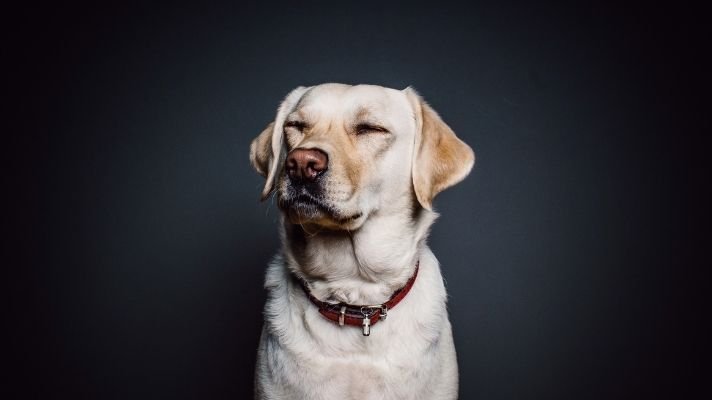
I’m sure you must have heard about this breed. Since 1991 Labrador Retriever ranks number one in the AKC’s (American Kennel Club) list of “most popular dog breeds.”
Labs are affectionate, fun-loving, and perfect for families. Labs were bred to be good for families as well as working dogs.
Note that they are highly energetic; requiring intense exercise on a daily basis. If you don’t have an active lifestyle, Lab isn’t for you.
In the past, they were known to be fishermen’s helpers. At present, modern Labradors are used by hunters for retrieving.
Friendliness
The main reason behind Lab’s popularity is its friendly and affectionate nature. If you are looking for a dog breed for your family, a Labrador Retriever can be a great addition. Labs get along with families, kids, other dogs, and strangers as well.
Grooming
Labs have double coats that shed all year round. They shed excessively twice a year – spring and winter. During winter, they shed and create a new coat layer in order to protect from winter elements. During the spring season, they shed to cool off. To keep their coat clean and healthy, occasional baths and weekly (preferably daily) brushing is required.
Physical Needs
Labradors are highly energetic. To help them utilize their excess energy the right way, it’s crucial to provide adequate exercise on a regular basis. In the absence of sufficient exercise, they may build destructive behavior. On average, an adult Labrador needs at least 1.25 hours of exercise daily.
Trainability
Labrador is one of the smartest dog breeds. In Stanley Coren’s (a professor of canine psychology) The Intelligence of Dogs book, the breed ranks number 7th. High intelligence level makes them easy to train.
BREED OVERVIEW
Origin: Newfoundland, Canada
Colors: Black, Chocolate, Yellow
Height: Male: 57-62 cm, Female: 55-60 cm
Weight: Male 29-36 kg, Female: 25-32 kg
Life Expectancy: 10-12 years
Also Read: 15 Best Companion Dogs For Labs
Golden Retriever
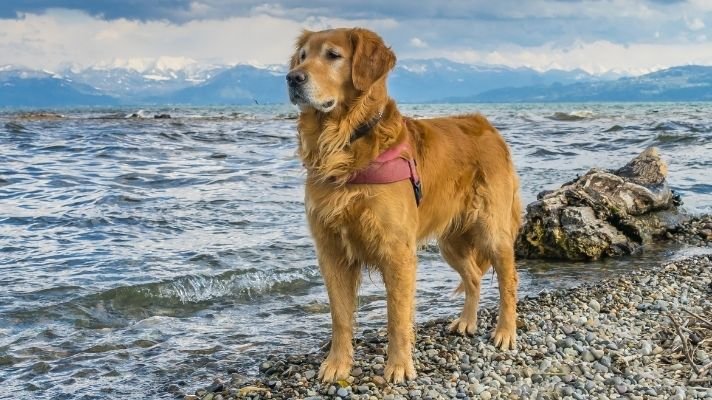
Golden Retriever is the second most popular retriever. The breed is friendly, intelligent, and devoted.
With a long coat and feathers around the body, Goldens look so beautiful. They are seen mainly in three colors: cream, golden, light golden, or dark golden.
Golden Retrievers were bred to retrieve shot birds during hunting and shooting parties. Their soft mouth allows them to retrieve birds undamaged.
Friendliness
Golden Retrievers are gentle, adorable, and friendly. They get along well with everyone, including family members, kids, other animals, and even strangers.
Grooming
Goldens shed moderately all year round and heavily in the spring and fall seasons. Paying attention to regular grooming can control excess shedding. Follow a routine of daily brushing and weekly/bi-monthly bathing to keep your canine coat healthy.
Physical Needs
Excess energy means higher exercise needs. As Goldens are very energetic, lack of sufficient exercise can make them destructive. They need at least one hour of high-quality exercise on a daily basis.
Trainability
Golden Retriever is a highly intelligent dog breed. In Stanley’s study, Goldie ranks number 4th. The breed is very obedient; teaching new commands won’t be time-consuming. It has the ability to learn more than 200 commands.
BREED OVERVIEW
Origin: Scottish Highlands
Colors: Cream, Golden, Light Golden, Dark Golden
Height: Male: 56-61 cm, Female: 51-56 cm
Weight: Male: 30-34 kg, Female: 25-32 kg
Life Expectancy: 10-12 years
Chesapeake Bay Retriever
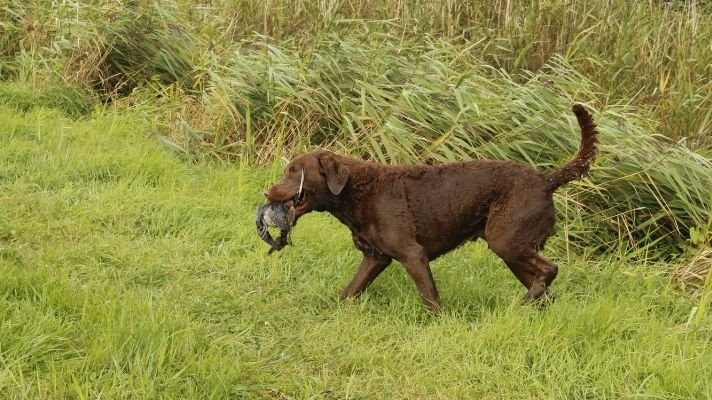
The Chesapeake Bay Retriever or Chessie originated in the chilly chop of Maryland’s Chesapeake Bay. Chessies were used to retrieve waterfowl, pull fishing nets, and rescue fishermen.
Today, Chessies are used as hunting dogs, watch dogs, and family companions.
The breed has wavy, thick, and waterproof coats. Their thick double-coats offer a layer of protection from cold water and winter elements.
Friendliness
Chessies get along well with family members, however, they may not do well with kids, other dogs, and strangers.
Grooming
The double coat of Chessies is thick and waterproof. They have a smooth undercoat and harsh outercoat. The grooming needs are limited. Brushing once or twice a week would be fine.
Physical Needs
Like Lab and Goldie, Chessie is also an energetic dog. Regular physical activities will help Chessie utilize excess energy the right way. The lack of enough exercise can result in issues like excess barking, excess chewing, etc.
Trainability
Chessies are stubborn and quite difficult to train. You will be spending more time on training. Besides early socialization and puppy training classes, also provide obedience training to your Chessie.
BREED OVERVIEW
Origin: Chesapeake Bay
Colors: Deadgrass, Sedge, Light Brown, Dark Brown, Tan, Brown
Height: Male: 58-66 cm, Female: 53-61 cm
Weight: Male: 30-36 kg, Female: 25-32 kg
Life Expectancy: 10-12 years
Curly-Coated Retriever
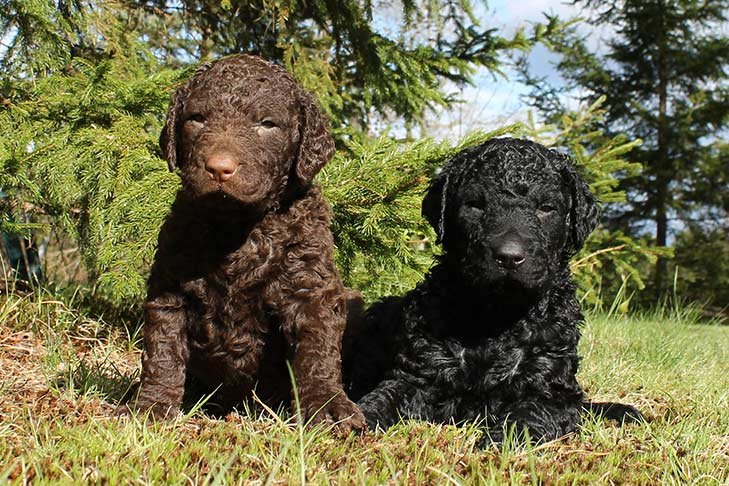
The Curly-coated is the oldest out of all the retriever dog breeds. In 1874, when the first purebred dog stud book was published by the British Kennel Club, Curly Coated and Flat-Coated were the first two recognized retriever breeds. There were more than 4000 dogs listed in the book, but no other retriever breeds were recognized.
Curly-coated retrievers’ coat is covered with small, waterproof curls. From the appearance, curlies might seem difficult to groom. However, their grooming needs are moderate.
Friendliness
This retriever breed is friendly and playful. It gets along well with families, kids, and other dogs. However, it can be distrustful of strangers.
Grooming
As Curly-Coated Retrievers don’t have an undercoat, they aren’t heavy shedders. Curlies shed a quite more two times a year: spring and fall. Grooming a Curly-Coated is quite easy. Unlike other retrievers, it doesn’t demand so much grooming.
Physical Needs
In order to keep a curly-coated retriever happy and stimulated, it’s imperative to provide enough exercise. Their exercise needs are slightly lower, compared to Labs and Goldens. If you own a Curly-Coated Retriever, provide at least 30 to 60 minutes of high-quality exercise every single day.
Trainability
Training a Curly-Coated Retriever is quite difficult because it isn’t as intelligent as Labrador and Golden Retriever. However, training can be easier when the right approach is used. Firstly, avoid repetitive training because Curly-Coated Retrievers hate repetitions. For the best results, try to make training sessions fun and exciting.
BREED OVERVIEW
Origin: England
Colors: Black, Liver
Height: Male: 64-69 cm, Female: 58-64 cm
Weight: Male: 32-41 kg, Female: 23-32 kg
Life Expectancy: 9-14 years
Flat-Coated Retriever
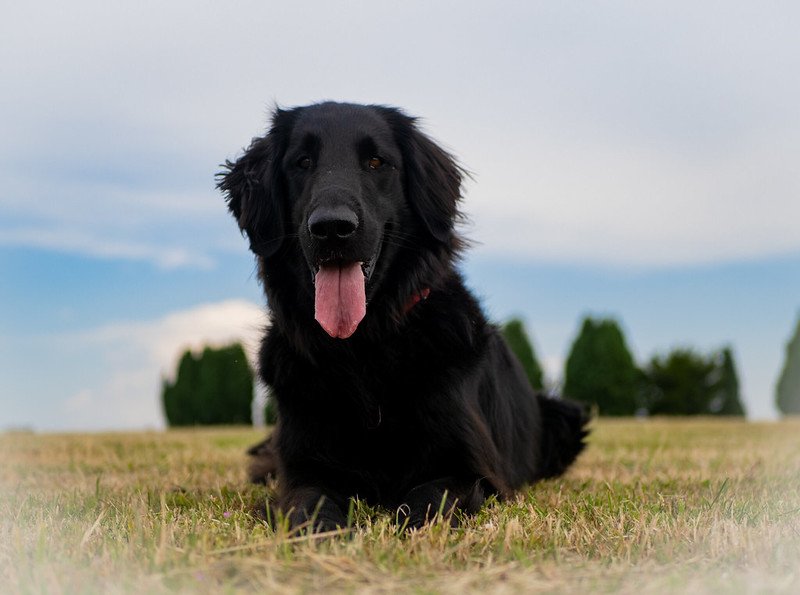
Flat-coated retriever originated in England in the mid-1800s. The breed has its ancestry from the Black Retriever, Newfoundland, and Border Collie.
At present, Flat Coat isn’t very popular, however, there was a time when it was so popular as a gun dog. In fact, it was recognized by AKC (in 1915) 10 years before Golden Retriever.
As compared to other dog breeds, flat-coated retrievers mature slowly. Its puppylike behavior can be seen even in adulthood. That’s the reason why it is often called the “Peter Pan” of retrievers.
Friendliness
Flat Coats are outgoing and affectionate. They get along well with family members with kids. As we have seen, the breed is the “Peter Pan” of retrievers, it can be a great companion for children. Flat Coats are friendly with other dogs and strangers as well.
Grooming
Flat-Coated Retrievers have a medium-length coat that requires moderate grooming. They are moderate shedders and they should be brushed at least once a week.
Physical Needs
The breed is highly energetic and active. To prevent destructive behavior, it’s imperative to provide regular exercise. To keep a flat-coated retriever physically fit, I recommend you provide at least 1.5 hours of quality exercise daily.
Trainability
Flat-coated retrievers are responsive and eager to please. For the best results, consider using reward-based training methods. The breed is sensitive; it won’t respond well to rigid training methods.
BREED OVERVIEW
Origin: England
Colors: Black, Liver
Height: Male: 59-62 cm, Female: 56-59 cm
Weight: Male: 27-36 kg, Female: 25-32 kg
Life Expectancy: 8-14 years
Nova Scotia Duck Tolling Retriever
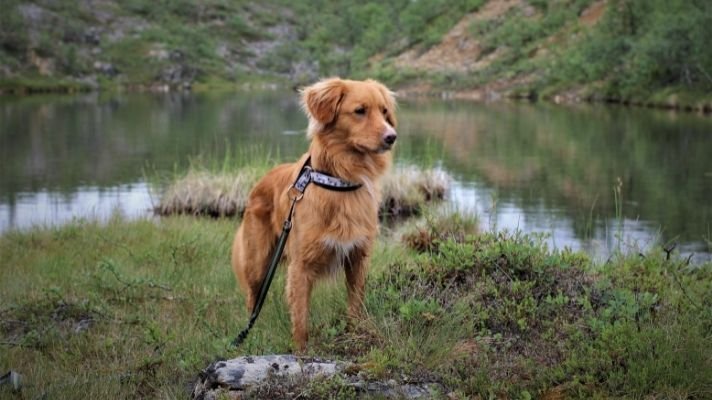
As the name suggests, Nova Scotia Duck Tolling Retriever was developed in Canada’s Nova Scotia. Specifically, it’s from Yarmouth County. Duck Toller was bred especially for hunting. It is referred to as Toller due to its ability to lure waterfowl within gunshot range.
It is the smallest of all retriever breeds. From the appearance, the breed may look like a small Golden Retriever. Since it’s a rare breed, you won’t find it easily from the breeder. Depending on its availability, a breeder may charge a bit extra than the average cost of a Duck Tolling Retriever.
The breed is perfect for someone looking for a very active and sporting dog breed.
Friendliness
Tollers are playful and affectionate. They get along well with family members, children, other dogs, and strangers.
Grooming
Tollers have a waterproof double coat which requires brushing once a week. They do shed throughout the year, but they shed even more during spring and fall. Brush daily during shedding seasons.
Physical Needs
Like other retrievers, Duck Tollers are also energetic. To keep a Toller tired and prevent excess energy build-up, consider giving at least one hour of daily exercise.
Trainability
Tollers are intelligent, but one of the main problems is they get bored easily. To get the best out of training sessions, keep them short and exciting. At times, they can be stubborn. Reward-based training can be a good way to motivate them to follow your commands.
BREED OVERVIEW
Origin: Yarmouth County, Nova Scotia, Canada
Colors: Red, Red Golden, Copper
Height: Male: 45-54 cm, Female: 42-51 cm
Weight: Male: 20-23 kg, Female: 17-20 kg
Life Expectancy: 10-14 years
FAQs
What is the best type of retriever breed?
Each retriever breed is different in some way or another. Which one’s right for you depends on your lifestyle and preferences.
For example, if you want a dog that’s ideal for apartment living, Nova Scotia Duck Tolling Retriever is right for you. Other retrievers aren’t good for apartment living.
And, if you are looking for an affectionate dog breed that gets along with almost everyone, except Chessie, all other retrievers are good.
Which is the most popular retriever dog breed?
The answer is Labrador Retriever. Since 1991, Lab ranks number one in the AKC’s list of “most popular dog breeds.” After Labrador, Golden Retriever is the second most popular retriever breed. Both these retrievers are smart, fun-loving, and energetic.
Final Thoughts
Though characteristics like physical appearance, popularity, grooming needs, intelligence level, etc. differ slightly from one retriever breed to another, retrieve drive remains the same in all.
After all, they are hunting dogs; they were bred primarily to help hunters retrieve birds and small animals undamaged.
Retrievers dogs are so energetic. As a result, they require plenty of exercise and physical activities every single day.
I’m sure this post helped you understand the differences between all retriever breeds and figure out which one is right for you.
TRAIN YOUR CANINE! ⬇️
[adinserter block="1"]
